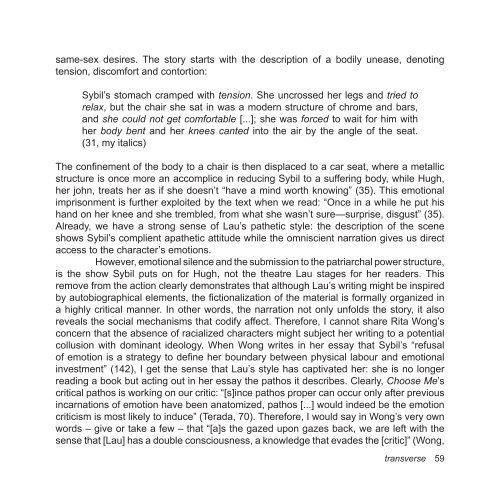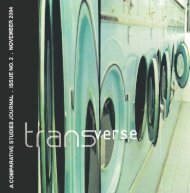Untitled - Centre for Comparative Literature - University of Toronto
Untitled - Centre for Comparative Literature - University of Toronto
Untitled - Centre for Comparative Literature - University of Toronto
Create successful ePaper yourself
Turn your PDF publications into a flip-book with our unique Google optimized e-Paper software.
same-sex desires. The story starts with the description <strong>of</strong> a bodily unease, denoting<br />
tension, discom<strong>for</strong>t and contortion:<br />
Sybil’s stomach cramped with tension. She uncrossed her legs and tried to<br />
relax, but the chair she sat in was a modern structure <strong>of</strong> chrome and bars,<br />
and she could not get com<strong>for</strong>table [...]; she was <strong>for</strong>ced to wait <strong>for</strong> him with<br />
her body bent and her knees canted into the air by the angle <strong>of</strong> the seat.<br />
(31, my italics)<br />
The confi nement <strong>of</strong> the body to a chair is then displaced to a car seat, where a metallic<br />
structure is once more an accomplice in reducing Sybil to a suffering body, while Hugh,<br />
her john, treats her as if she doesn’t “have a mind worth knowing” (35). This emotional<br />
imprisonment is further exploited by the text when we read: “Once in a while he put his<br />
hand on her knee and she trembled, from what she wasn’t sure—surprise, disgust” (35).<br />
Already, we have a strong sense <strong>of</strong> Lau’s pathetic style: the description <strong>of</strong> the scene<br />
shows Sybil’s complient apathetic attitude while the omniscient narration gives us direct<br />
access to the character’s emotions.<br />
However, emotional silence and the submission to the patriarchal power structure,<br />
is the show Sybil puts on <strong>for</strong> Hugh, not the theatre Lau stages <strong>for</strong> her readers. This<br />
remove from the action clearly demonstrates that although Lau’s writing might be inspired<br />
by autobiographical elements, the fi ctionalization <strong>of</strong> the material is <strong>for</strong>mally organized in<br />
a highly critical manner. In other words, the narration not only unfolds the story, it also<br />
reveals the social mechanisms that codify affect. There<strong>for</strong>e, I cannot share Rita Wong’s<br />
concern that the absence <strong>of</strong> racialized characters might subject her writing to a potential<br />
collusion with dominant ideology. When Wong writes in her essay that Sybil’s “refusal<br />
<strong>of</strong> emotion is a strategy to defi ne her boundary between physical labour and emotional<br />
investment” (142), I get the sense that Lau’s style has captivated her: she is no longer<br />
reading a book but acting out in her essay the pathos it describes. Clearly, Choose Me’s<br />
critical pathos is working on our critic: “[s]ince pathos proper can occur only after previous<br />
incarnations <strong>of</strong> emotion have been anatomized, pathos [...] would indeed be the emotion<br />
criticism is most likely to induce” (Terada, 70). There<strong>for</strong>e, I would say in Wong’s very own<br />
words – give or take a few – that “[a]s the gazed upon gazes back, we are left with the<br />
sense that [Lau] has a double consciousness, a knowledge that evades the [critic]” (Wong,<br />
transverse 59




